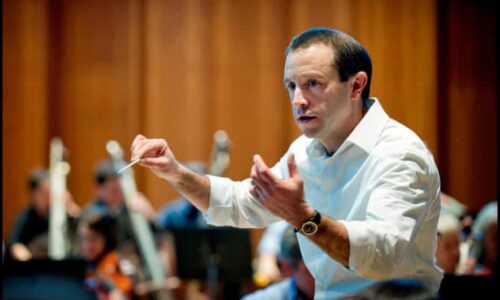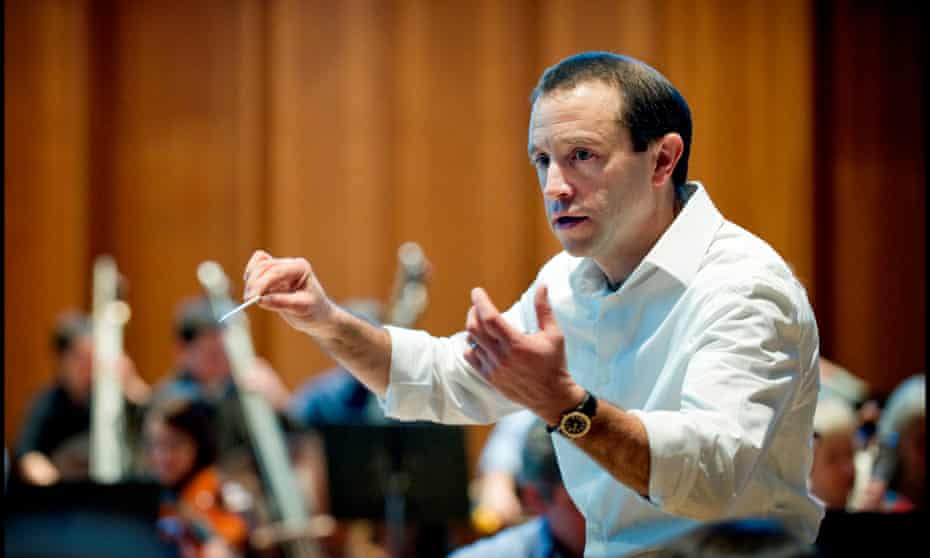 United Kingdom Mozart, Shostakovich: Elizabeth Atherton (soprano), Peter Rose (bass), Scottish Chamber Orchestra / Mark Wigglesworth (conductor). City Halls, Glasgow, 5.11.2021. (GT)
United Kingdom Mozart, Shostakovich: Elizabeth Atherton (soprano), Peter Rose (bass), Scottish Chamber Orchestra / Mark Wigglesworth (conductor). City Halls, Glasgow, 5.11.2021. (GT)

Mozart – Symphony in D major, after Serenade K320 ‘Posthorn’
Shostakovich – Symphony No.14 in G minor, Op.135
The last time I heard the Shostakovich Fourteenth was with this orchestra at the Edinburgh International Festival in 2011 in a superb performance conducted by Robin Ticciati. I thought then that I would never hear a finer performance. However, this concert exceeded my expectations not only for the orchestral performance but in the two singers – we had world-class levels in the interpretation of one of this composer’s finest late works.
The rarity of live performances of this extraordinary chamber work reveal its problem for both audiences and players. This could be put down to a score predominantly concerned with death which makes it a difficult piece to programme. To share this symphony with a classical one by Mozart is a good choice, as there are many parallels between the two composers; both were established from an early age, and both wrote huge amounts of music in diverse genres; in his youth, Shostakovich played Mozart extensively and was sometimes called the ‘Russian Mozart’.
Mozart composed his D major Symphony from the ‘Posthorn’ Serenade that was written during his Salzburg period marking the departure of students from the university – suitably invoking the post horn heard on departing coaches from the city. Mozart could only hear the piece a couple of times so to make best use of his music he arranged some from the first, fifth and seventh movements to earn his finely written composition a longer life. This rarely heard piece opened on a grand note in the first movement (Adagio maestoso-Allegro con spirito), with bright woodwind and especially Cerys Ambrose-Evans’s bassoon lending a dramatic colour, along with bright harmonies from the horn of Fabian van de Geest, and dramatically emphasised with splendid thumps from Louise Goodwin on timpani. In the second movement (Andantino) there was a tragic, almost funereal mood – yet which explored a broader degree of emotion accentuated by fine oboe playing from Robin Williams, while in the finale (Presto), the mood was lively and dramatic bringing out all the effervescence of the original serenade, before closing in a vibrantly joyous mood.
This ensemble has rarely performed repertoire from Russia, yet the appointment of Maxim Emelyanychev as Music Director three years ago has led to several new pieces entering their concert programmes; last season Tchaikovsky’s Pathetique Symphony and Rimsky-Korsakov’s Scheherazade were announced in quite a radical change in the programming for the orchestra. The origins of Shostakovich’s Fourteenth Symphony was motivated by the composer orchestrating Musorgsky’s Songs and Dances of Death in 1962, and also influenced by his friendship with Benjamin Britten (to whom the symphony is dedicated). Shostakovich’s 1966 heart attack ultimately brought him to compose this work thinking that his life’s work might be closer to an end. The selection of texts by Lorca, Apollinaire, Küchelbecker and Rilke lend a particular aspect of universality to the composer’s masterpiece. Of course, Shostakovich was following several notable paradigms in writing a song symphony (think, Mahler, Berlioz and Zemlinsky) and of course by 1969 the composer had already long departed from any interest in socialist realism with Babi Yar, his choral Thirteenth Symphony.
In the first two poems from Lorca, De profundis – about two lovers transfixed in death – the motif of Dies irae is quoted intermittently, and Malagueña, set in a taverna, there emerge folk melodies and twelve-note figures on the strings. The third movement, La Loreley, from Apollinaire is perhaps one of the emotional centres of the work, in the dialogue between the bishop and Lorelei before she plunges into the Rhine, the words ‘O, bishop, my eyes are full of flame, let then my sorcery be set afire’ were magnificently sung by Elizabeth Atherton. She also superbly characterised Le Suicidé, with masterly accompaniment from the cello of Will Conway. Les Attentives I – the tale about a soldier doomed to die in a trench – was wonderfully accompanied by the xylophone in a rondo style, another heart-breaking passage was heard in À la Sante, of a prisoner awaiting his execution where the woodblock against col legno strings emphasised the drama and tragedy. In the ninth movement, the deep grave bass intonation of Peter Rose in Küchelbecker’s O, Del’vig, Del’vig!, brought out all the significance of a poet’s reward of death in opposing tyrants, ‘Immortality is equally the lot of bold, inspired deeds and sweet songs!’ Finally, in Rilke’s Der Tod des Dichters – in the tenth movement – the Dies irae motif returned symbolising the closeness of death, and at last, the brief epilogue, the Schlussstück, or Conclusion, the words ‘All-powerful is Death’ brought this masterpiece to a stunning culmination leading to a thundering reception from the audience.
Notable throughout this performance were the effect of the tubular bells and the xylophone played by Louise Goodwin and Kate Openshaw which at significant moments evinced the intensity of the poems, and one must mention the outstanding Elizabeth Atherton who was magnificent in her dramatization of every nuance in the texts – from the longings of a lost lover to the heartbreak of a mother who has lost her child, and she was matched fully by the magnificent bass Peter Rose. Mark Wigglesworth’s conducting of the orchestra used every aspect of the City Hall’s acoustic which is ideally suited for chamber music. The striking virtuosic solos and brief stunningly played passages showed that the Scottish Chamber Orchestra have this music in their blood. In all, this concert will surely prove a major highlight of the season.
Gregor Tassie
